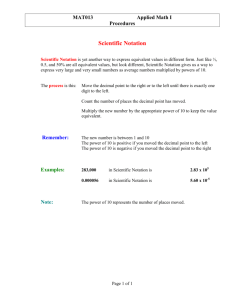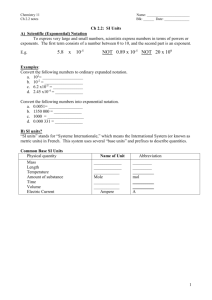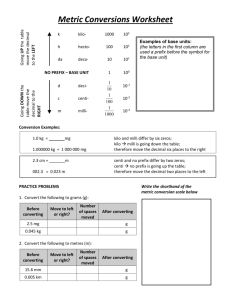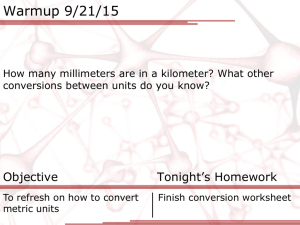Base SI Units
advertisement
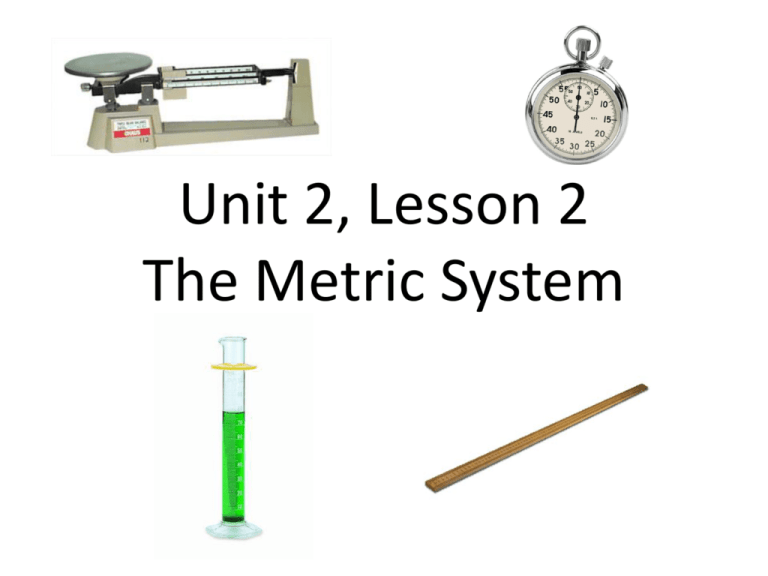
Unit 2, Lesson 2 The Metric System Did You See That? • We all know that the ability to describe an observation is very important. • A description is a statement that reports what has been observed. It is said that long, long ago, people used the length of the king’s foot to settle arguments about how long or wide something was. So that everyone would know how long his foot was, the king passed out sticks the same length as his foot. The sticks were called the ruler’s foot or “rulers.” • Then, about 200 years ago, someone decided that measurement systems would be better based on Mother Earth than some king’s foot. • Also, basing measurements on body parts was not accurate because body parts vary in size from person to person. • So, using mathematics, they figured out the distance from the equator to the north pole. • And divided that distance by: Here 10 Million! Here • And the answer to that division problem was named: The Meter • So now, measurements became descriptions that included numbers and units, and a whole system of measurement was developed with the meter as its basis. • This system of measurements is called the International System of Units (SI) or the Metric System. The International System of Units • SI units are a common international language for ALL scientific measurements. It helps scientists from all over the world compare observations and results. • The Metric System is based on units of 10 either by dividing units by the number 10 or multiplying them by some multiple of 10. • Considering the various numbers we use in the English system (12 inches to a foot, 3 feet to a yard, 1760 yards to a mile, etc.) multiplying or dividing by 10 makes the Metric System seem much easier. Base SI Units • There are seven base SI units that are used to express different quantities of length, mass, time, temperature, amount of substance, electric current and light intensity. Base SI Units • The Meter (m) is the SI unit of length. Length is generally measured with a meterstick or measuring tape. • The Gram (g) is the unit for mass. Mass is generally measured with a balance. • The Kelvin (K) is the unit for temperature. Temperature is generally measured with a thermometer. • The Second (s) is the unit for time. Time can be measured with a stopwatch. • The Ampere (A) is the unit for electric current. Electric currents can be measured with amp meters. • The Mole (mol) is the unit for the amount of substance. Moles are usually measured by equations. • The Candela (cd) is the unit for light intensity. Light intensity can be measured with a lux meter. Derived SI Units • Some SI units are derived units. A unit that is calculated from a base unit. • The Cubic Meter (m³) is used for the volume of solids. These can be measured with a graduated cylinder or beaker. • The Liter (L) is used for liquid volume, which is not actually an SI unit. One milliliter is equal to one cubic centimeter (cm³). • The Newton (N) is used for weight. Weight can be measured with different types of scales and can depend on an object’s mass. • Measurements like Density must be calculated and cannot be measured directly. Density is calculated by dividing an object’s mass by its volume. SI Prefixes • The metric system uses prefixes to express an SI unit that is larger or smaller than the base unit. SI Prefixes • The prefix kilo- (k), from the Greek word chilioi, means 1000. Example: kilometer. • The prefix hecto- (h), from the Greek word hekaton, means 100. Example: hectometer • The prefix deca- (da), from the Greek word deka, means 10. It is the only SI prefix that uses more than one letter. Example: decameter. • The prefix deci- (d), from the Latin word decimus, means tenth. Example: decimeter. • The prefix centi- (c), from the Latin word centum, means 100. Example: centimeter. • The prefix milli- (m), from the Latin word mille, means 1000. Example: millimeter. • The prefix micro- (µ), from the Greek word mikrós, means small, and is denotes one millionth. It is the only prefix that uses a Greek letter as its symbol (pronounced “mu”) Scientific Notation • Scientific Notation is a short way of representing very large numbers or very small numbers. • Numbers in scientific notation are written in the form: a x 10ᵇ • The value of “a” is usually a number between 1 and 10. • With a decimal, locate the decimal point and move it to the left or right until it is immediately after the numeral that becomes “a”. • The exponent “b” tells how many places the decimal point is moved. • If the decimal moves to the left, “b” will be positive. If the decimal moves to the right, “b” will be negative. Scientific Notation Example Problems • The speed of light is 300,000,000 m/s, what is this measurement in scientific notation? 300,000,000. Move the decimal 8 places to the left until it reaches the 3. “a” = 3 “b” = 8 (for the amount of places the decimal was moved, and positive because the decimal was moved to the left). Answer: Speed of light = 3 x 10⁸ m/s Scientific Notation Example Problems • The size of a particular plant cell is 0.00004 m. What is this measurement in scientific notation? 0.00004 Move the decimal 5 places to the right until it reaches the right side of the 4. “a” = 4 “b” = -5 (for the amount of places the decimal was moved, and negative because it was moved to the right). Answer: Size of plant cell = 4 x 10⁻⁵ m Accuracy and Precision • Accuracy is a description of how close a measurement is to the true value of the quantity being measured. • The smaller the difference between the measurement and the true value, the more accurate the measurement is. • Precision is the exactness of the measurement. • A precise measurement is repeatable and reliable. • If a high precision measurement is repeated, the number obtained will be the same or very nearly the same. Estimating Measurements • People can make estimations when doing everyday tasks like rearranging furniture. • Scientists may estimate to see if the data they collected is reasonable. • Scientists may also estimate to determine which tool is best suited for making the measurements they need.
